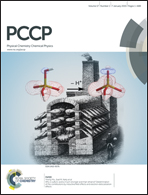Strong temperature-dependent crystallization, phase transition, optical and electrical characteristics of p-type CuAlO2 thin films
Abstract
We report here a reliable and reproducible single-step (without post-annealing) fabrication of phase-pure p-type rhombohedral CuAlO2 (r-CuAlO2) thin films by reactive magnetron sputtering. The dependence of crystallinity and phase compositions of the films on the growth temperature was investigated, revealing that highly-crystallized r-CuAlO2 thin films could be in situ grown in a narrow temperature window of ∼940 °C. Optical and electrical property studies demonstrate that (i) the films are transparent in the visible light region, and the bandgaps of the films increased to ∼3.86 eV with the improvement of crystallinity; (ii) the conductance increased by four orders of magnitude as the film was evolved from the amorphous-like to crystalline structure. The predominant role of crystallinity in determining CuAlO2 film properties was demonstrated to be due to the heavy anisotropic characteristics of the O 2p-Cu 3d hybridized valence orbitals.


 Please wait while we load your content...
Please wait while we load your content...